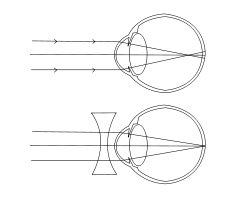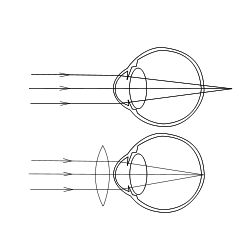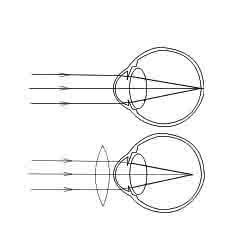 Myopia (nearsighted)
Myopia (nearsighted)
| MadSci Network: Physics |
The condition of nearsightedness has the technical name "myopia", and one can find information about that at places such as Wikipedia. The Wikipedia page on myopia is here. The "opposite" condition, farsightedness, is known technically as "hyperopia", and information on it can be found here at Wikipedia.
From Wikipedia I have borrowed the following two images. The upper one is of myopia and the lower one is of hyperopia, and the lower "eyeball" of each set shows the type of lens that would be used to correct the conditions. The upper "eyeball" of each set indicates the position of the image that would be formed from a very distant object whose light "rays" are nearly collimated (parallel) when they reach the eye.
 Myopia (nearsighted)
Myopia (nearsighted)
 Hyperopia (farsighted)
Hyperopia (farsighted)
Yes, the condition of myopia can be simulated using lenses. From the information above one can discern that myopia is characterized by the fact that the image of an object forms in front of the retina. So, if someone with normal vision wanted to simulate myopia, what type of lens would that person need to put in front of their eyes to make the image of an object form in front of the retina? If you said "convex" or "positive" lens, you would be correct! You can see that effect in the lower image above where a positive lens is used to correct hyperopia: the positive lens causes the image to form farther toward the front of the eye. So if one used that lens with a "good" eye (neither myopic nor hyperopic) it would be a simulation of myopia.
I have actually done this kind of simulation using reading glasses. My uncorrected vision is nearly perfect (except for some astigmatism), so if I put on reading glasses my far vision if blurred, but I can see objects close up. This is exactly the characteristic of myopia! The picture below is what a "good" eye sees both with and without the positive lens:
 Simulated myopia
Simulated myopia
If one were to move the object (which, in the pictures, is very far away to the left) closer to the eye its image would move farther and farther back toward the retina, and when the object is "close" to the eye the image formed by the eye + positive lens will actually be sufficiently focussed on the retina to obtain a good image. That is how reading glasses work.
John Link, MadSci Physicist
Try the links in the MadSci Library for more information on Physics.